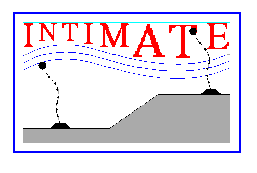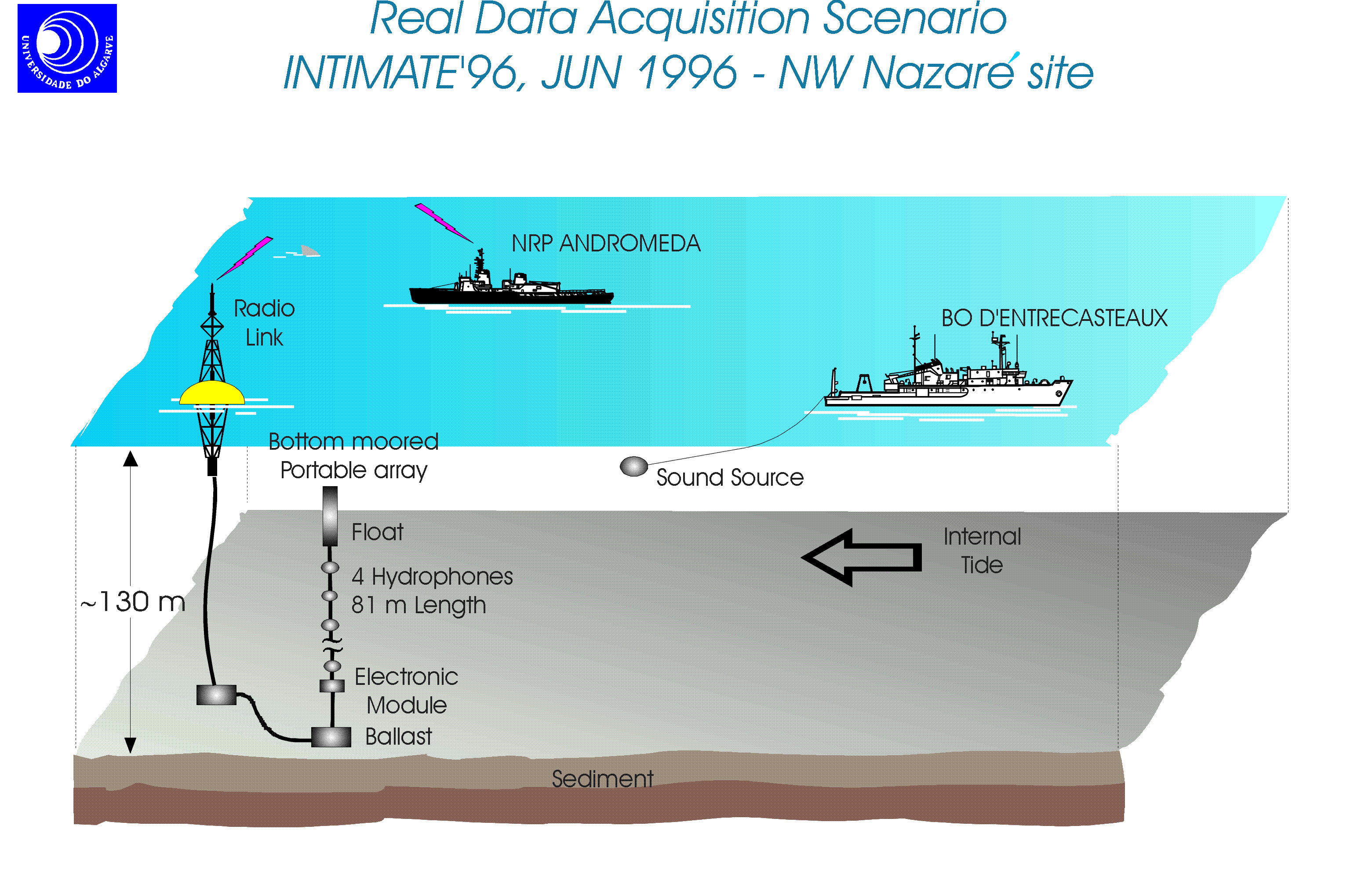
INternal TIde Measurements with Acoustic Tomography Experiments
(INTIMATE)
[PRAXIS XXI contract 2/2.1/MAR/1698/95]
Sérgio M. Jesussjesus@ualg.pt
UCEH - Universidade do Algarve,
Campus de Gambelas,
PT-8000 Faro, Portugal
Yann Stephanstephan@shom.fr
CMO - Service Hidrographique Oceanographique de la Marine,
Brest, France
Emanuel F. Coelho
oceanografia@hidrografico.pt
Instituto Hidrográfico,
Rua das Trinas 49,
PT-1296 Lisboa, Portugal
Michael B. Porter porter@oalib.njit.edu
Centre of Applied Mathematics,
New Jersey Institute of Technology,
NJ Newark, USA
Abstract
Today acoustics is one of the main tools for ocean exploration. Inspired
by a technique from biomedical engineering, Ocean Acoustical Tomography (OAT)
consists of the use of one or more acoustic sensors/sources strategically
distributed in a volume of water and simultaneously emitting and
receiving coded signals. The ``comparison'' of the emitted and
received signals allows for the acoustical characterization of the
environment in between the source(s) and the receiver(s). The
experiments that have been performed to date, mainly in deep water,
showed that it is possible to estimate: (1) the temperature over
the water column, (2) the physical characteristics of the seabottom
and (3) the velocity and direction of currents.
Due to the large water mass involved and its periodic nature,
internal tides signatures have been frequently observed during ocean
tomography experiments in the Bay of Biscay. In the continental shelf,
internal tides are extremely important to the study of the
coastal dynamics with a very special relevance close to the
shelf break and to topographic irregularities like submarine
canyons. This project aims at proving the concept of using vertical
arrays of sensors and acoustic sources in the band 50 - 400 Hz
for tomographic estimation of the oceanographic
characteristics of internal tides on the continental shelf
up to 200 m depth. During the project, areas of interest near the
coast will be selected for at sea testing including
the validation of the tomographic results with ground truth
measurements. The conclusions of this study are hoped to bring
a better knowledge of the internal tide phenomena and its
impact on the coast dynamics. This should lead to improved prediction
accuracy for coastal dynamical models and to a better management
of existing resources. The results will also be important
in providing more refined predictions of the
impact of potential ecological accidents and climate changes.
Objectives
- To conduct a theoretical/parametric study for determining
the performance of a source-receiver system for the inversion of
oceanographic parameters in shallow water. Determine the
characteristics of the system (frequency, resolution, array
aperture, depth, etc.,...) for an optimal performance on typical
scenarios off the portuguese/french coast using oceanographic archival
data.
- To establish the capabilities of the tomographic system to
study internal tides on the continental shelf. Test of
theoretical-parametric models and estimation of their
characteristic parameters.
- To test the complete system in preselected coastal areas and
validate it with ground truth data.
- To draw conclusions on the limitations of the theoretical and
operational methods that were developed. Make recommendations
for future developements of OAT systems in shallow water and
their use for studying internal tides.
Plan of activities
During INTIMATE the following important milestones are forseen:
- a first small scale sea trial for testing the feasibility of
the project, along the portuguese coast, nearby Lisbon.
- from the conclusions of the first sea trial, both from the
sea trial design and the data analysis, a second full scale sea
trial his planned in conjunction with the MINT (CMO-SHOM) experiment
along the French coast nearby Brest.
- a third sea trial in another location to be chosen based on
the experience of the first two experiments.
INTIMATE'96 sea trial
Short description
The first small scale sea trial, INTIMATE'96, took place
near the Nazaré site from 14 to 19 of June 1996.

Two research vessels were involved: the NRP ANDROMEDA and the
BO D'ENTRECASTEAUX. BO D'ENTRECASTEAUX was towing a sound source
and emmiting coded signals along pre-determined geometries. NRP
ANDROMEDA was lying dead in the water nearby a 4 hydrophone vertical
array receiving radio signals and recording the data. The receiving
vertical array was loaned by courtesy of SACLANT Undersea Research Centre,
La Spezia, Italy.
Ground truth measurements
A number of environmental measurements were performed simultaneously with
the acoustic data transmissions:
- bathymetry surveys of the area and along transmission lines
- bottom moored ADCP data at the vertical array location
- thermistor chains at the vertical array location
- CTD data at the vertical array location
- hull mounted ADCP on the source ship
- XBT data from the source ship
- CTD data over night and along the area
- seismic survey with Uniboom
- cores along source tracks
Data analysis (see Ocean
Acoustic Library for more results on line)
Superficial analysis of the CTD data at the vertical array location
shows evidence of a approximately 12 hour period movement of the
thermocline with an amplitude of about 10 m/s extending from 10 to 30 m
depth.
Cross-correlograms of the received and emitted signals shows a very stable
channel impulse response both for the flat bottom and range dependent transects.
Source localization using single hydrophone data and the full source frequency
band has been possible for both the stationnary and the moving source events.
INTIMATE'98 sea trial
INTIMATE'98 toke place during July 1998 in the shallow water zone
at the border of the continental platform SW from Brest, France. Two
sources and two receiving arrays were employed along a number of
transects for tomographic reconstruction. Three research vessels were
involved: the ALCYON, the LAPEROUSE and the HMS ROEBUCK.
INTIMATE'99 sea trial
INTIMATE'99 toke place from 19 to 23 July 1999 in the Troia Peninsula,
near Setubal, Portugal (see INTIFANTE'99 Sea
Trial )
INTIFANTE'00 sea trial
INTIFANTE'00 is taking place from 9 to 29 October 2000 in the Tróia
Peninsula, near Setubal, Portugal (see INTIFANTE'00
Sea Trial )
Publications and reports
- JESUS S.M. and PORTER M.B., ``Shallow water tomography for internal
tide estimation: preliminary results of INTIMATE'96.'', SACLANTCEN SCNR Meeting,
Lisbon, October 1996.
- COELHO E., JESUS S., PORTER M. and STEPHAN Y., ``Preliminary acoustic
results from the INTIMATE 96 shallow water tomography experiment'',
ONR/ARPA Shallow-water Acoustic Workshop, Washington DC, October 1996.
- JESUS S.M. e PORTER M.B., ``Shallow water tomography for internal
tide estimation: preliminary results of INTIMATE'96.'', SACLANTCEN SCNR
Meeting, Lisboa, 1996.
- STEPHAN Y, DEMOULIN X., JESUS S., COELHO E.F. and PORTER M.B., ``Internal
tide impact measured by acoustic tomography experiment (INTIMATE)'', 132
Meeting of the Acoust. Soc. Am., Hawai, December 1996.
- COELHO E., JESUS S., PORTER M. and STEPHAN Y., ``One-way active tracking in
the INTIMATE 96 Experiment'', EAST Symposium, Washington DC, February 1997.
- PORTER M.B., JESUS S., STEPHAN Y., DEMOULIN X. and COELHO E., ``Exploting
reliable features of the ocean channel response'', Proc. of SWAC'97, Beijing,
April 1997.
- DEMOULIN X., STEPHAN Y., JESUS S., COELHO E. and PORTER M.B., ``INTIMATE96:
a shallow water tomography experiment devoted to the study of internal tides'',
Proc. of SWAC'97, Beijing, April 1997.
- PORTER M.B., STEPHAN Y., DEMOULIN X., JESUS S. and COELHO E.,
``Shallow-water tracking in the sea of Nazaré'' Undersea Technology'98,
IEEE Ocean Engineering Society, Tokyo, Japan, 1998.
- JESUS S.M., PORTER M.B, STEPHAN Y., COELHO E. and DEMOULIN X,
``Broadband source localization with a single hydrophone'', Proc. OCEANS'98,
pp. 1078-1082, Nice, France, 1998.(abstract).
- RODRIGUEZ O.C., JESUS S., STEPHAN Y., PORTER M., COELHO E., ``Internal tide
acoustic tomography: reliability of the normal modes expansion as a possible
basis for solving the inverse problem'', 4th European Conf. on Underwater
Acoustics, pp. 587-592, Rome, Italy, September
1998 (abstract).
- PORTER M.B., JESUS S.M., STEPHAN Y., COELHO E., DEMOULIN X.,
``Single-phone source tracking in a variable environment'', 4th
European Conf. on Underwater Acoustics, pp. 575-580, Rome, Italy,
September 1998.
- JESUS S. M., PORTER M.B., STEPHAN Y., DEMOULIN X., RODRIGUEZ O.
and COELHO E., ``Single hydrophone source localization'',
(abstract), IEEE Journal of Oceanic
Engineering,
(pdf file), Vol.25, no.3, pp.-337-346 1998.
- PORTER M.B.,STEPHAN Y., DEMOULIN X., JESUS S. and COELHO E.,
``Shallow-water tracking in the sea of Nazaré'', submitted to IEEE
Journal of Oceanic Eng., October 1998.
- PORTER M.B., JESUS S., STEPHAN Y., DEMOULIN X., COELHO E., ``Using the
echo pattern to range a sound source'', Proc. of First International Symposium
on Physics in Signal and Image Processing, Paris, January 1999.
- O.C. RODRÍGUEZ, S.M. JESUS, Y. STEPHAN, X. DEMOULIN, M.B. PORTER
and E. COELHO, ``Nonlinear soliton interaction with acoustic signals: focusing
effects'', Int. Conf. on Theoretical and Computational Acoustics,
Trieste, Italy 1999.
- JESUS S.M., ``Internal Tide Measurements with Acoustic Tomography
Experiments (INTIMATE)'', SACLANTCEN SCNR Meeting, La Spezia, Italy, 1999.
- RODRIGUEZ O.C., JESUS S.M., PORTER M.B., STEPHAN Y., DEMOULIN X
e COELHO E., ``Dynamics of acoustic propagation through a soliton wave
packet: observations from the INTIMATE'96 experiment'', in Experimental
Acoustics Inversion Methods for Exploration of the Shallow Water
Environment, Ed.Caiti, Hermand, Jesus and Porter, KLUWER, 1999.
- Y.STEPHAN, T. FOLEGOT, X. DEMOULIN, M.PORTER, S. JESUS e
E. COELHO, ''The interaction of Sound and Tides'', in Experimental
Acoustics Inversion Methods for Exploration of the Shallow Water
Environment, Ed.Caiti, Hermand, Jesus and Porter, KLUWER, 1999.
- M.B. PORTER, S.M. JESUS, Y. STEPHAN, X. DEMOULIN e
E.COELHO, ``Tidal effects on source inversion'', in Experimental
Acoustics Inversion Methods for Exploration of the Shallow Water
Environment , Ed.Caiti, Hermand, Jesus and Porter, KLUWER, 1999.
- RODRIGUEZ O.C., JESUS S., STEPHAN Y., DEMOULIN X., PORTER M. and
COELHO E., ``Nonlinear Soliton Interaction with Acoustic Signals: Focusing
effects'', (abstract), Journal of Computational
Acoustics,
(gziped ps file), accepted 2000.
- RODRIGUEZ O.C. e JESUS S.M.,``Physical limitations of travel time based
shallow water tomography''(abstract), Journal
of the Acoustical Society of America,
(pdf file),
accepted 2000.
- DEMOULIN X., STEPHAN Y., COELHO E., FOLEGOT T., JESUS S.M., and
PORTER M.B., ''Estimating equivalent bottom geoacoustical parameters
from broadband inversion'', 5th European Conference on Underwater Acoustics,
pp. 191-196, Lyon, France, 2000.
- JESUS S.M., PORTER M.B., STEPHAN Y., COELHO E., RODRIGUEZ O.C.
and DEMOULIN X., ''Single sensor source localization in a range dependent
environment'', (abstract)
MTS/IEEE Oceans 2000, Providence, USA, 2000.
- RODRIGUEZ O.C. and JESUS S.M., "Range-dependent regularization of
travel-time tomography based on theoretical modes'',
(pdf)
accepted ECUA'02, June.
- MARTINS N.E. and JESUS S.M., ``Blind Channel Estimation with Data from
the INTIMATE'96 sea trial'',
(pdf)
accepted MED'2002, June.
- TOLSTOY A., JESUS S.M. and RODRIGUEZ O., "Tidal effects on MFP via
the INTIMATE'96 test",
(pdf)
accepted Acoustic Variability Conf., Lerici, Italy, September.
- TOLSTOY A., JESUS S. and RODRIGUEZ O., "Tidal MFP inversion for water
depth and source range in the Intimate96 Test",
(abstract)
submitted to the ASA Meeting, December 2002.
last update on Jun 21, 2002


